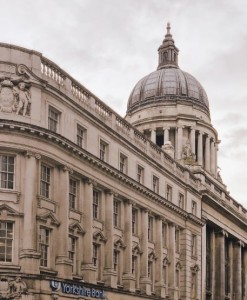At one point high street banks were among the most important amenities to the community. They were essential for opening accounts, getting out money, paying in cheques, and even exploring products like mortgages and insurance. Today we can do all of this online. As a result, many banks have closed. Others have made big changes to their commercial architecture to continue serving customers. We want to take a look at the evolution here and what you can expect from modern high street banks.
Traditional banks
 Before the internet boom you would usually find multiple banks on every single high street. A lot of them had quite grand designs in terms of the architecture. The aim here was to give customers feelings of professionalism, security, and wealth. That way they would be more likely to trust the bank with their own money.
Before the internet boom you would usually find multiple banks on every single high street. A lot of them had quite grand designs in terms of the architecture. The aim here was to give customers feelings of professionalism, security, and wealth. That way they would be more likely to trust the bank with their own money.
The interior of these banks was also designed to showcase professionalism and security. You could see it in everything from the vaults to the counters. However, this approach did not do much to make customers feel comfortable. In fact, there could often be a feeling of discomfort because of the Spartan interiors. This did highlight the human aspect though. Some customers even went as far as learning the names of the bank managers they saw so frequently.
Big changes
Technology drove the evolution of the commercial architecture of banks. With more accessible services online, people didn’t need to go into a physical building as often. In fact, it largely only became necessary if there are issues or to talk to a human for advice about specific products or services.
There were several big changes here. Firstly, the number of counters fell. Instead self service machines became more prominent. Today most banks only have small counters with space for a few advisers.
From an external point of view, classic designs for banks are far less popular. While some retain the traditional structures, newer bank commercial architecture tends to favour things like glass facades and uplighting. They are attractive to look at and give a sense of trust, but don’t have the same grand feel.
The interiors are far more comfortable too. You will see things like nice chairs to make people want to sit and spend time getting help. The idea here is to make it so the people that do come into the banks would have a nice experience. It will ensure they get a great service and think well of the brand. In turn that could lead to customer loyalty.
The decor has also changed massively. Previously bank interiors would be rather cold but with elements like gold to display an idea of wealth. Today you are more likely to find splashes of bold colour. It makes everything more inviting and gives a sense of optimism. Plus, a lot of banks are also looking at biophilic design to incorporate greenery into spaces.
Do you need help with commercial architecture?
The evolution of high street banks and focus on customer experience is definitely interesting. It should give you plenty of ideas of what you can try with your own projects, even if they are different types of businesses. Things like comfortable interiors and embracing technology can work for almost any industry, especially retail and hospitality.
If you are thinking of ideas for your commercial architecture, we would love to help. You can rely on Coffey Architects to provide creative insights and the very best support. So, contact us today.